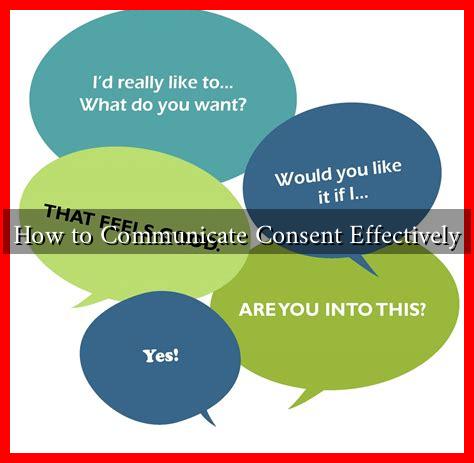-
Table of Contents
How to Communicate Consent Effectively
Consent is a fundamental aspect of any relationship, whether it be romantic, platonic, or professional. It is essential to ensure that all parties involved feel comfortable and respected. However, communicating consent effectively can often be challenging. This article explores the nuances of consent communication, providing valuable insights and practical tips for fostering a culture of respect and understanding.
Understanding Consent
Before diving into effective communication strategies, it is crucial to understand what consent truly means. Consent is not merely the absence of a “no”; it is an enthusiastic and affirmative “yes.” It should be:
- Informed: All parties should have a clear understanding of what they are consenting to.
- Freely Given: Consent must be given without any form of pressure or coercion.
- Revocable: Anyone can change their mind at any time, and that decision should be respected.
- Specific: Consent for one activity does not imply consent for another.
The Importance of Clear Communication
Effective communication is the cornerstone of obtaining and respecting consent. Misunderstandings can lead to uncomfortable situations, and clear dialogue can help prevent these issues. Here are some strategies to enhance communication:
1. Use Clear Language
Avoid ambiguous terms or euphemisms. Instead, use straightforward language that leaves no room for misinterpretation. For example:
- Instead of saying, “Are you okay with this?” try “Do you want to continue?”
- Replace “I guess we could” with “I would like to.”
2. Ask Open-Ended Questions
Encourage dialogue by asking open-ended questions that invite the other person to express their feelings and preferences. For instance:
- “How do you feel about this?”
- “What are your thoughts on moving forward?”
3. Non-Verbal Cues Matter
While verbal communication is vital, non-verbal cues also play a significant role in consent. Pay attention to body language, facial expressions, and tone of voice. If someone seems hesitant or uncomfortable, it’s essential to pause and check in with them.
Creating a Safe Environment
For effective consent communication, it is crucial to create a safe and comfortable environment. Here are some tips:
- Choose the Right Setting: Ensure that the conversation takes place in a private and relaxed atmosphere.
- Be Respectful: Approach the topic with sensitivity and respect for the other person’s feelings.
- Encourage Honesty: Let the other person know that their feelings and opinions are valued and that they can speak freely.
Case Studies and Statistics
Research shows that effective communication about consent can significantly reduce instances of sexual assault and misunderstandings in relationships. According to a study published in the Journal of Interpersonal Violence, individuals who engage in open discussions about consent are 50% less likely to experience coercive situations.
Moreover, a survey conducted by the Rape, Abuse & Incest National Network (RAINN) found that 63% of individuals reported feeling more empowered to express their boundaries when they had previously discussed consent with their partners.
Conclusion
Communicating consent effectively is essential for fostering healthy relationships and ensuring that all parties feel respected and valued. By using clear language, asking open-ended questions, and creating a safe environment, individuals can enhance their ability to communicate consent. Remember, consent is an ongoing conversation, not a one-time agreement. By prioritizing open dialogue and mutual respect, we can cultivate a culture where consent is understood and honored.
In summary, effective consent communication is about clarity, respect, and ongoing dialogue. By implementing these strategies, we can contribute to a safer and more respectful society.


